Intranets
Your guide to the central source of truth your organization needs to stay informed, aligned, and connected
Quick jump to
What is an intranet?

An intranet software is a private, internal network exclusively accessible to authorized members of an organization. It serves as a secure digital platform designed to facilitate seamless internal communications, collaboration, and information sharing among employees. Essentially, it functions as a company's internal website, meticulously crafted to streamline operations and significantly boost productivity.
By centralizing information, intranets act as a single source of truth, an employee intranet provides easy access to critical company documents, policies, procedures, and news. This eliminates the need for time-consuming searches and ensures everyone is working with the most up-to-date information. Additionally, intranets provide a secure platform for employees to communicate with each other, share documents, and collaborate on projects. This fosters a more collaborative work environment, breaks down silos, and promotes knowledge sharing.
Furthermore, many intranets offer self-service tools that empower employees to access HR information, IT support, and other essential resources independently. This not only saves time but also fosters a sense of autonomy and responsibility. Additionally, intranets can be customized to create personalized workspaces for different departments or teams, fostering a strong sense of community and belonging. This customization allows teams to collaborate more effectively and efficiently.
Modern intranets can seamlessly integrate with other systems like email, calendars, and enterprise resource planning (ERP) software. This integration eliminates the need for multiple logins and data silos, streamlining workflows and improving overall efficiency. By streamlining processes and reducing paper usage, intranets can also help save costs. Additionally, they can reduce the need for physical meetings and travel, further contributing to cost savings.
Intranets offer a multitude of benefits for organizations. They enhance communication by facilitating seamless interaction between employees, reducing reliance on email and phone calls. This leads to faster response times, improved decision-making, and stronger relationships. Additionally, intranets foster collaboration by providing a shared workspace, promoting teamwork, and knowledge sharing. This collaborative environment breeds innovation, problem-solving, and higher-quality work.
By providing easy access to information and tools, intranets significantly boost employee productivity. By reducing time spent searching for information and streamlining processes, intranets empower employees to focus on their core tasks. Moreover, intranets can help foster a positive company culture by sharing news, celebrating successes, and recognizing achievements. This strengthens employee morale, increases engagement, and builds a stronger sense of community.
Types of Intranets
Internal Website
Intranets come in various forms, each tailored to specific organizational needs and goals. One common type is the internal website. These intranets serve as a centralized hub for company information, such as policies, procedures, and news. They often feature a traditional website structure with a homepage, navigation menus, and content pages. While effective for sharing information, they may lack the collaborative features and social interactions that modern workplaces demand.
AI-powered Intranets
In recent years, AI-powered intranets have emerged, leveraging artificial intelligence to enhance user experience and productivity. These intranets can use AI-powered search to quickly find relevant information, automate routine tasks, and provide personalized recommendations. AI-powered intranets can significantly improve efficiency and decision-making within organizations.
Social Intranets
Another type of intranet is the social intranet. This type of intranet emphasizes social interaction and employee engagement. It often includes features like social feeds, groups, and discussion forums, allowing employees to connect, share ideas, and collaborate on projects. Social intranets can foster a strong company culture, improve employee engagement, and drive innovation.
Front-door Intranets
Front-door intranets are designed to be the first point of entry for employees when they log into their work devices. They provide a unified and personalized experience, offering quick access to essential tools, applications, and information. This type of intranet aims to streamline workflows and improve productivity by eliminating the need to search for information across multiple platforms.
Mobile-first Intranets
Mobile intranets are optimized for mobile devices, recognizing the increasing trend of remote work and flexible work arrangements. They provide a seamless user experience on smartphones and tablets, allowing employees to access information and collaborate on the go. This is particularly important for field workers, remote teams, and those who frequently work outside the traditional office setting.
Benefits of an Intranet

Intranets offer a multitude of benefits for organizations. They enhance communication by facilitating seamless interaction between employees, reducing reliance on email and phone calls. This leads to faster response times, improved decision-making, and stronger relationships. Additionally, intranets foster collaboration by providing a shared workspace, promoting teamwork, and knowledge sharing. This collaborative environment breeds innovation, problem-solving, and higher-quality work.
By providing easy access to information and tools, intranets significantly boost employee productivity. By reducing time spent searching for information and streamlining processes, intranets empower employees to focus on their core tasks. Moreover, intranets can help foster a positive company culture by sharing news, celebrating successes, and recognizing achievements. This strengthens employee morale, increases engagement, and builds a stronger sense of community.
Intranets also offer significant cost savings. By streamlining processes and reducing paper usage, intranets can help save costs. Additionally, they can reduce the need for physical meetings and travel, further contributing to cost savings. Furthermore, intranets enhance security by providing a controlled environment for information sharing. By limiting access to authorized users, organizations can protect sensitive data and mitigate security risks.
Strategies for a Successful Intranet
A successful intranet is more than just a digital platform; it’s a powerful tool that can transform the way your organization operates. To maximize its potential, consider these strategic approaches:
Design a User-centric intranet
A successful intranet should be designed with the user in mind. A clean, intuitive interface can guide users effortlessly through the platform. Personalizing content and features to individual roles and preferences can enhance user experience and increase engagement. Additionally, mobile optimization ensures seamless access to the intranet from various devices, empowering employees to stay connected and productive on the go.
Foster a Collaborative Culture
A collaborative intranet can foster a strong company culture. Social features like discussion forums, blogs, and social feeds encourage interaction and knowledge sharing. Dedicated team workspaces provide a centralized platform for teams to collaborate on projects, share ideas, and build relationships. Implementing tools like wikis and document libraries can facilitate knowledge sharing and empower employees to become experts in their field.
Drive Effective Communication
Effective communication is essential for a successful intranet. A centralized news feed can keep employees informed about company announcements, updates, and important information. Targeted communication, such as personalized notifications and email alerts, ensures that the right information reaches the right people at the right time. Interactive tools like polls, surveys, and quizzes can engage employees, gather feedback, and foster a sense of community.
Integrate with Business Systems
Seamless integration with business systems can streamline workflows and improve efficiency. Single Sign-On (SSO) simplifies access to multiple applications with a single login, reducing frustration and saving time. Data synchronization ensures that information is consistent across different systems, eliminating data silos and improving decision-making. Automation of routine tasks can free up employees' time to focus on more strategic work.
Drive Effective Communication
Effective communication is essential for a successful intranet. A centralized news feed can keep employees informed about company announcements, updates, and important information. Targeted communication, such as personalized notifications and email alerts, ensures that the right information reaches the right people at the right time. Interactive tools like polls, surveys, and quizzes can engage employees, gather feedback, and foster a sense of community.
Business Impacts of an Intranet

Intranets offer a multitude of business benefits. They significantly enhance internal communication, fostering a more connected and collaborative work environment. By centralizing information and streamlining access, intranets reduce the time employees spend searching for information, leading to increased productivity. One study found that employees who use an intranet are 25% more productive.
Intranets also play a crucial role in knowledge management. By providing a platform for employees to share their expertise and best practices, intranets can accelerate innovation and problem-solving. Additionally, they can significantly reduce onboarding time for new employees by providing easy access to company policies, procedures, and resources.
Intranets strengthen company culture. By sharing company news, celebrating successes, and recognizing employee achievements, intranets can boost employee morale and engagement. Another study found that companies with social recognition programs reported a 14.9% improvement in employee engagement, productivity, and customer service.
Finally, intranets can improve intranet security by providing a controlled environment for sharing sensitive information. By limiting access to authorized users, organizations can protect confidential data and minimize the risk of security breaches.
Intranets offer a wide range of business benefits, including:
- improved communication
- increased productivity
- enhanced knowledge sharing
- stronger company culture, and
- increased security
Challenges and Solutions for Intranets
Intranet Adoption
One significant intranet hurdle is user adoption. Encouraging employees to use the intranet regularly can be difficult, especially if it's not user-friendly or doesn't offer value. It's essential to design an intuitive interface, provide clear instructions, and offer ongoing training and support. Also, promoting the intranet through regular communication and highlighting its benefits can help drive adoption.
Intranet Content Quality
Another challenge is maintaining content quality and relevance. As information changes rapidly, it's crucial to keep the intranet up-to-date and accurate. This requires a dedicated team to manage content, ensure it's well-organized, and remove outdated information. Encouraging employee contributions can help keep the content fresh and relevant.
Intranet Security
Furthermore, security is a major concern when managing an intranet. Sensitive company information must be protected from unauthorized access. Strong security measures, such as user authentication, access controls, and regular security audits, are essential to safeguard the intranet. Additionally, employee training on security best practices can help prevent accidental breaches.
Intranet Best Practices
Prioritize the User
To ensure the success of an intranet, organizations should adopt several best practices. First and foremost, the intranet should be designed with the user in mind. A user-friendly interface, intuitive navigation, and personalized content can significantly enhance user experience and encourage adoption.
Maintain Content
An intranet should be regularly updated and maintained. Outdated information can lead to confusion and frustration. A dedicated content management team can ensure that the intranet is always up-to-date and relevant. Additionally, encouraging employee contributions can help keep the content fresh and engaging.
Optimize Intranet Integrations
Intranets should be integrated with other business systems, such as email, calendars, and CRM systems. This integration can streamline workflows and improve productivity. Furthermore, the intranet should be mobile-friendly, allowing employees to access information and collaborate on the go.
Intranet Use Cases
Central Source of Trust
An intranet can serve as a single source of truth for all company information, including policies, procedures, and news. This eliminates the need for employees to search for information in multiple locations and ensures that everyone is working with the same information.
Enhanced Collaboration
Intranets provide a platform for employees to collaborate on projects, share ideas, and brainstorm solutions. Features such as document sharing, project management tools, and discussion forums can facilitate teamwork and improve productivity.
Improved Communications
Intranets can be used to disseminate important company announcements, share news, and facilitate communication between employees. This can help to reduce misunderstandings, improve decision-making, and foster a stronger company culture.
Employee Onboarding
Intranets can be used to streamline the onboarding process for new employees. By providing access to essential information, such as company policies, benefits information, and training materials, intranets can help new employees to quickly become productive members of the team.
Knowledge Management
Intranets can be used to create a knowledge base, where employees can share their expertise and best practices. This can help to improve problem-solving, innovation, and overall organizational performance.
Comparing Intranets
Choosing the right intranet platform is crucial for organizational success. Traditional options like Google Sites, while familiar, lack scalability and often fail to engage employees. Top-down intranet platforms can be costly and complex to manage, while wikis, enterprise search tools, and social platforms have their limitations in terms of knowledge management and governance.
Happeo offers a unique approach that combines the best aspects of these traditional solutions. By centralizing information, fostering collaboration, and empowering employees with AI-powered tools, Happeo addresses the challenges of modern knowledge management.
Compare different intranet vendors and see which one is right for you
Happeo vs. the Rest—Learn how Happeo's platform and unique approach stacks up against competitors.
The Future of Intranets
The future of intranets is bright, with advancements in technology promising to revolutionize the way organizations communicate and collaborate. AI-powered tools will enhance search capabilities, automate content creation, and personalize user experiences. As remote and hybrid work models continue to gain traction, intranets will become even more essential for fostering a strong company culture and keeping employees connected. By leveraging the power of automation, virtual and augmented reality, and advanced analytics, intranets will evolve into dynamic, immersive platforms that drive productivity and innovation.
Learn more about how Happeo's AI knowledge base that powers their intranet platform.

Intranets for Enterprises
Enterprise intranets are tailored to the unique needs of large organizations. Unlike smaller businesses, enterprises often have complex structures, diverse workforces, and stringent security requirements. A robust enterprise intranet addresses these challenges by providing:
- Scalability: The ability to accommodate a large number of users and handle increasing data volumes.
- Advanced Security: Robust security measures to protect sensitive information and comply with industry regulations.
- Complex Integration: Seamless integration with various enterprise systems, such as HR, finance, and CRM.
- Customizable Workflows: Tailored workflows to optimize business processes and improve efficiency.
- Granular User Permissions: Precise control over user access to information and resources.
By investing in a comprehensive enterprise intranet, organizations can enhance collaboration, streamline operations, and drive innovation.

Intranet FAQs
What is an intranet?
An intranet is a private network accessible only to authorized users within an organization. It's like a company's internal website, providing a secure platform for communication, collaboration, and knowledge sharing.
How does an intranet benefit my organization?
Intranets offer numerous benefits:
- Improved Communication: Facilitates seamless communication between employees, reducing email clutter.
- Enhanced Collaboration: Provides tools for teamwork, such as document sharing and project management.
- Increased Productivity: Streamlines workflows and reduces search time for information.
- Boosted Employee Morale: Creates a sense of community and fosters a positive work environment.
What are the key features of an intranet?
Key features of an intranet include:
- Centralized Knowledge Base: A repository for company policies, procedures, and resources.
- Document Sharing: Tools for sharing and collaborating on documents.
- Communication Tools: Forums, chat rooms, and messaging systems for real-time communication.
- Calendar and Scheduling: For planning and coordinating events and meetings.
- Employee Directory: A searchable directory of employees and their contact information.
- Search Functionality: Powerful search capabilities to find information quickly.
How can I ensure my intranet is user-friendly?
To create a user-friendly intranet:
- Keep it Simple: Avoid clutter and unnecessary complexity.
- Prioritize Content: Organize content logically and make it easy to find.
- Test Regularly: Conduct user testing to identify pain points and areas for improvement.
- Provide Clear Navigation: Use intuitive menus and clear labeling.
- Offer Training: Provide training to help employees navigate the intranet effectively.
Are intranets secure?
Intranets are highly secure, as they are typically protected by firewalls and access controls. By implementing strong security measures, you can safeguard your organization's sensitive information.
Does an intranet help in remote-first organizations?
Absolutely! Intranets are essential for remote work. They provide a virtual workspace where remote employees can access company resources, collaborate with colleagues, and stay connected to the organization's culture.
How can I measure the success of my intranet?
Key metrics to measure intranet success include:
- User Adoption: Track the number of active users and their engagement.
- Content Consumption: Monitor how often content is viewed and accessed.
- Search Queries: Analyze search queries to identify information gaps and improve search functionality.
- Employee Satisfaction: Conduct surveys to gauge employee satisfaction with the intranet.
What is the cost of implementing an intranet?
The cost of implementing an intranet varies depending on factors such as the size of your organization, the complexity of the solution, and the level of customization required.
How long does an intranet implementation take?
The implementation timeline depends on several factors, including the size of your organization, the complexity of the project, and the chosen implementation approach. A well-planned and executed intranet project can typically be implemented within a few months. Happeo has the fastest rollouts in the market due to its seamless integration with Google, reducing manual profile creation and content uploads. Happeo also has AI-powered features to fast track content creation and site management.
What are common intranet implementation pain points?
Common challenges include:
- Resistance to Change: Overcoming employee resistance to new tools and processes.
- Data Migration: Migrating existing content and data to the new platform.
- Integration with Existing Systems: Ensuring seamless integration with other systems.
- Ongoing Maintenance: Maintaining the intranet and keeping it up-to-date.
By addressing these challenges and following best practices, you can successfully implement and maintain a valuable intranet for your organization.
How can I get started building an intranet?
To get started on creating an intranet, first define your goals. Identify what you want the intranet to achieve, whether it's internal communication, knowledge sharing, or employee collaboration. Then, set clear objectives, such as improving employee engagement or streamlining workflows.
Next, plan your intranet's structure. Categorize information logically and create a sitemap to visualize the navigation. Choose the right platform, considering both commercial and open-source options, and ensure it has features like user management, content management, search functionality, and integration with other systems.
Design your intranet with user experience in mind. Keep it simple, use intuitive navigation, and make it mobile-friendly. Populate it with relevant content, including articles, videos, and infographics, and regularly update it.
Finally, launch and promote your intranet. Announce the launch, provide training, and encourage feedback. Continuously monitor usage, gather feedback, and make adjustments to improve the intranet over time.
What types of intranets are there?
Choosing the right platform to serve as your organization's central knowledge hub is crucial for success. The market offers a variety of solutions, each with its own strengths and weaknesses.
Understanding these options is essential to making an informed decision. Let's explore the common approaches organizations take and uncover the challenges associated with each.
Native operating system tools
Native existing tools like Google Sites are low-cost and familiar but lack scalability and integration. Content management is challenging, and they often fail to drive employee engagement or action.
Top-down intranet platforms
While they offer customization and AI capabilities, these options are costly and complex to manage. While they centralize information, driving adoption and maintaining content freshness can be difficult.
Team-based wikis
Wikis foster collaboration but lack governance and control. Information can be scattered and outdated, making it hard to find reliable content. Without a broader communication strategy, their impact is limited.
Enterprise search
Search-specific tools help find information but don't guarantee accuracy or relevance. They lack context and fail to address the root problem: fragmented knowledge.
Enterprise social platforms
Enterprise social tools excel at engagement but often prioritize social interactions over work-related content. While they build community, they may not effectively address knowledge management needs.
Happeo's All-in-One Approach
Happeo’s approach has two parts: bring everything into one platform and power that platform with AI. Happeo strikes the perfect balance to provide the benefits of all these approaches while simultaneously mitigating the downsides, removing complexity and automating with AI. Happeo provides a solution for:
- Knowledge management
- Intranet
- Internal Comms
- Enterprise Search
- Employee Engagement
What are some intranet content ideas?
Here are some intranet content ideas to keep your employees engaged and informed:
News and Announcements:
- Company news and updates
- Upcoming events and deadlines
- Employee spotlights and achievements
- Birthday and work anniversary celebrations
Company Policies and Procedures:
- Employee handbook
- HR policies and procedures
- IT policies and procedures
- Safety guidelines and emergency procedures
Knowledge Base:
- Frequently Asked Questions (FAQs)
- How-to guides and tutorials
- Best practices and tips
- Technical documentation
Collaboration Tools:
- Shared calendars and team schedules
- Project management tools
- Document sharing and collaboration platforms
- Discussion forums and chat rooms
Employee Resources:
- Benefits information
- Employee assistance programs (EAPs)
- Health and wellness resources
- Training and development opportunities
Fun and Engagement:
- Employee surveys and feedback forms
- Games and quizzes
- Contests and challenges
- Virtual coffee breaks and social events
By providing a variety of engaging content, you can help create a more informed, connected, and productive workforce. Happeo has an intranet engagement guide which includes 12 months of engagement ideas. Download it here.
Why Happeo?

Happeo is more than an intranet; it's your organization's digital brain. Unlike traditional approaches that silo information and frustrate employees, Happeo brings together knowledge, communication, people, and search into a single, unified platform. By eliminating the time wasted searching for information and fostering a culture of continuous learning, Happeo empowers employees to work smarter together and delivers organizational productivity.
With Happeo, you’re not just investing in a tool; you're investing in your organization’s future. Our AI-powered Knowledge Engine transforms information into actionable actionable knowledge, helping you identify knowledge gaps and optimize your workforce. By centralizing information and encouraging knowledge sharing, Happeo safeguards your organization's intellectual capital and reduces the risk of critical knowledge loss.
Imagine a workplace where employees are:
-
Empowered to make better business decisions independently
-
Engaged in a more meaningful way
-
Productive at the user, team, and organization level.
With Happeo, this vision becomes a reality. By aligning people, processes, and technology, Happeo helps organizations transform from the inside out.
Happeo Intranet Product Features
Our platform features work together to create an ecosystem for productivity and efficiency for your business. Learn more below about everything that comes together to make Happeo the best modern intranet for Google Workspace.
Pages
Drive productivity and collaborate with ease in Happeo Channels. Create any Channel you want for any purpose your business needs.
Learn more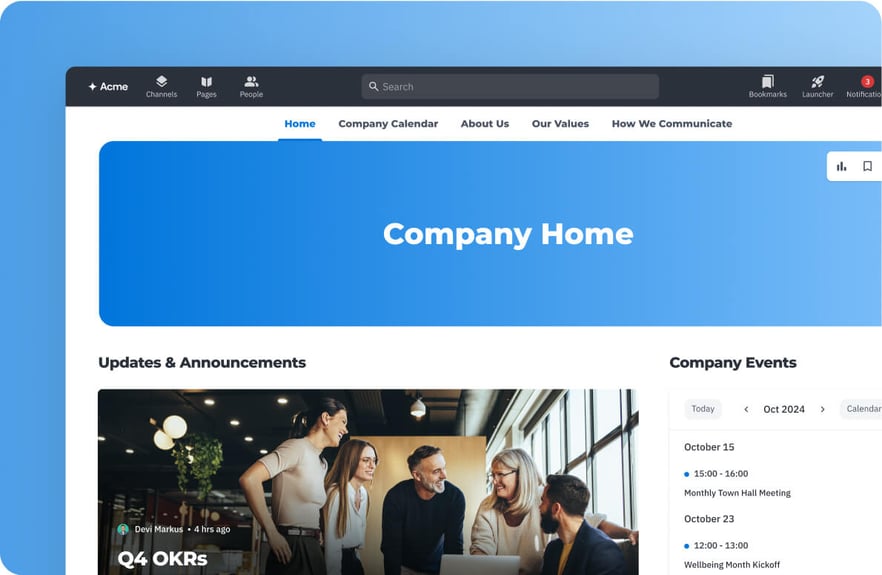
Channels
Drive productivity and collaborate with ease in Happeo Channels. Create any Channel you want for any purpose your business needs.
Learn more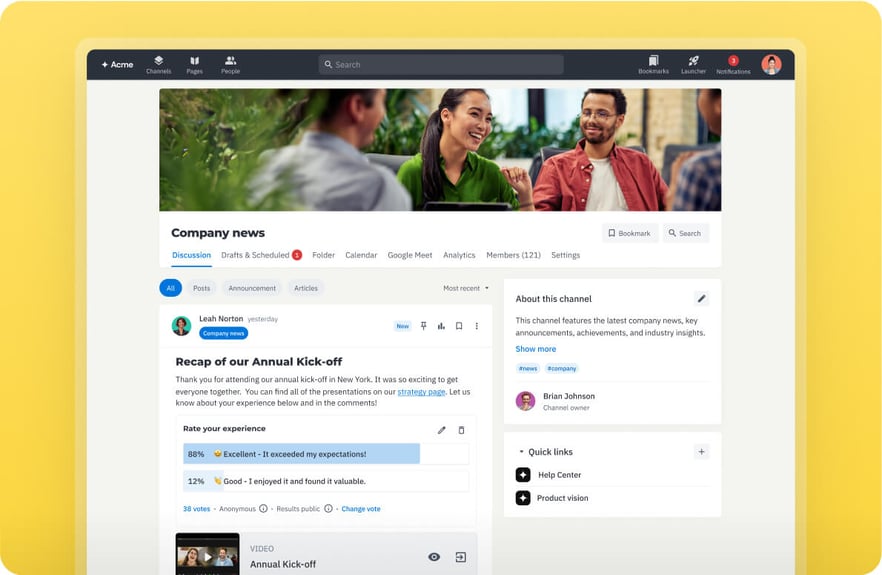
Search
Make knowledge and information easily discoverable with federated Search and Search AI. All you have to do is ask.
Learn more
Knowledge Engine
Drive knowledge further, faster. Happeo’s proprietary Knowledge Engine makes capturing, creating, and sharing knowledge across your organization easy with the power of AI.
Learn more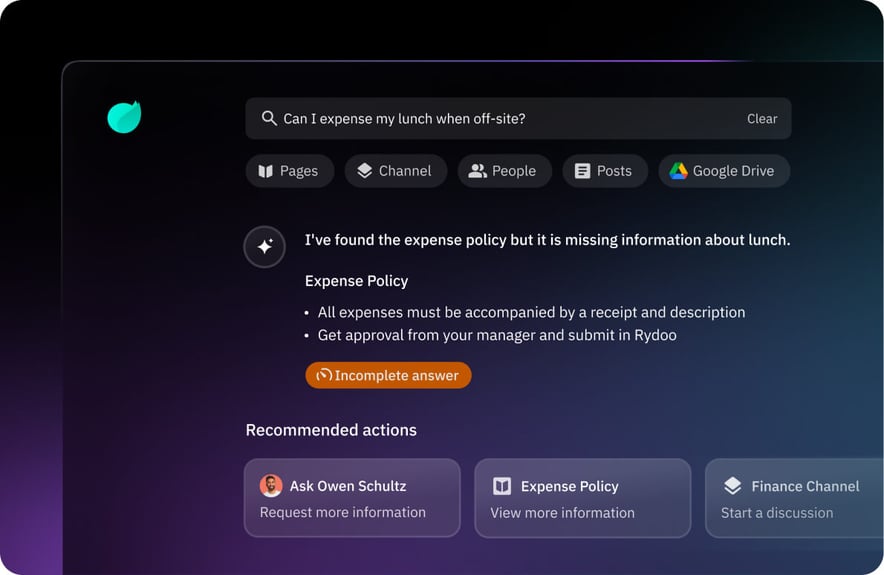
People
Bring everyone together across the organization as one team moving toward one purpose. From our in-app org chart to easy access management and Channels for collaboration, Happeo supports every employee across every team.
Learn more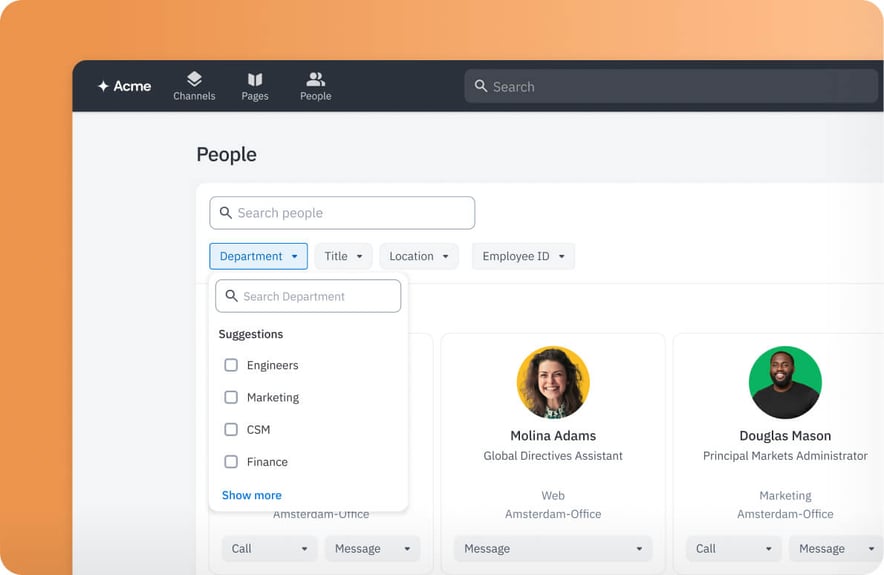
Analytics
Want to unlock the full potential of your platform? Happeo Analytics offers a comprehensive overview of user behavior, content performance, and search trends. Gain valuable insights to optimize your strategy and drive engagement.
Learn more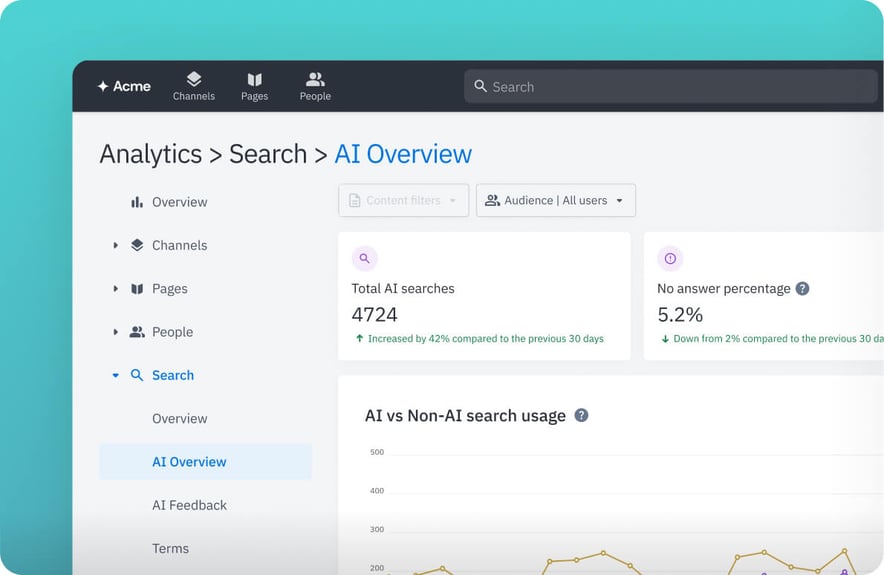
Governance
Take control of your digital workspace with Happeo's robust governance features. From granular permissions and streamlined user provisioning to advanced analytics and branding customization, Happeo empowers you to optimize your platform and safeguard your data.
Learn more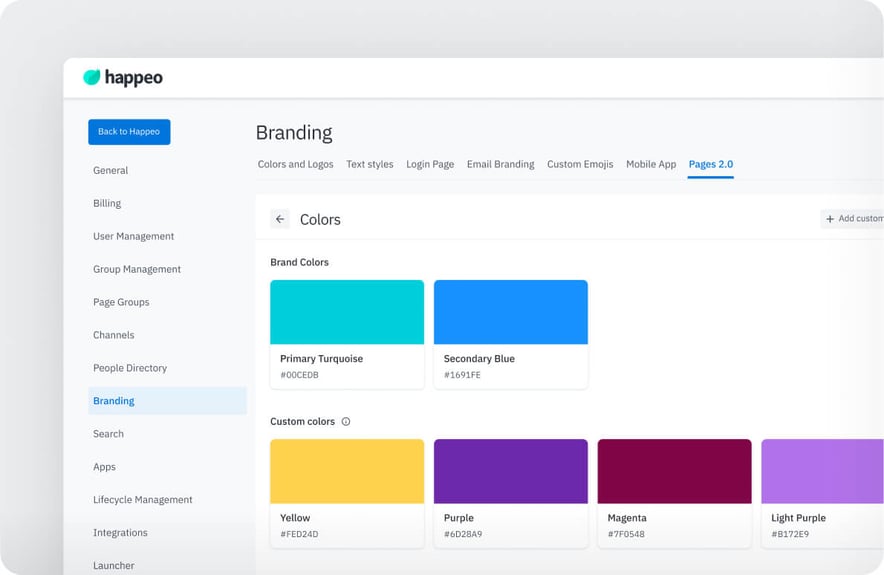
Mobile
The Happeo mobile app empowers and connects your entire workforce– anytime, anywhere. Give access to essential features and knowledge to your employees on-the-go so they can keep up with the latest updates, collaborate with colleagues, and find the information they need.
Learn more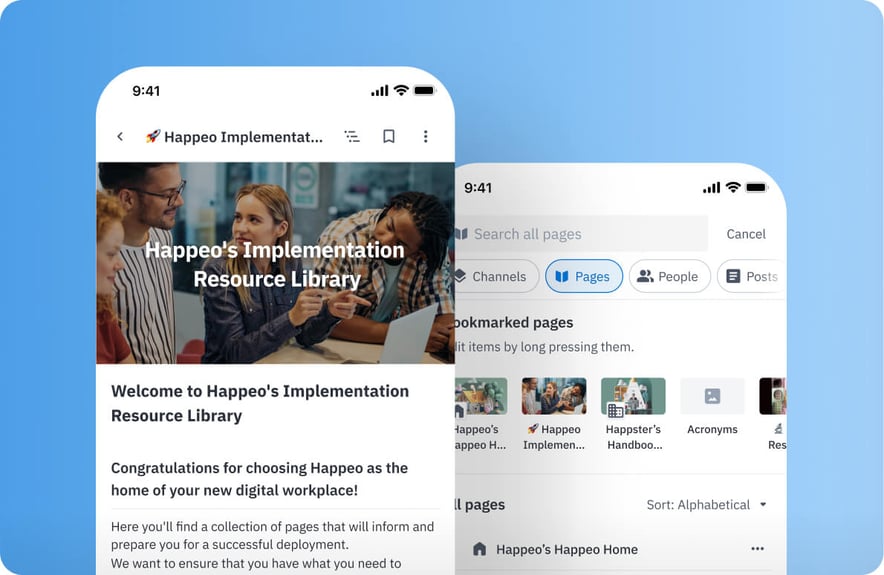
Our Intranet-themed blogs
Get started with a Happeo Intranet
Curious to see Happeo in action? You can:












